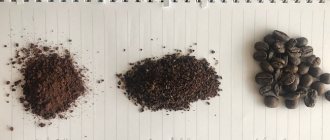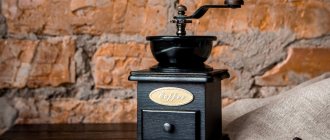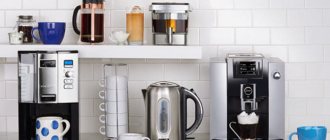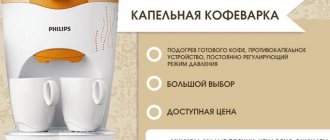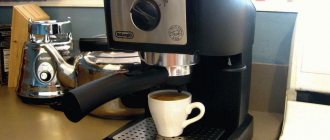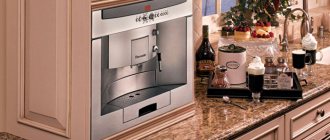It is not always possible to reveal the true taste and aroma of coffee beans; it mainly depends on the quality of the grind, the freshness of the roast and the original product itself. And such a powder can only be obtained in a manual coffee grinder, when soul, love and the desire to enjoy a wonderful drink are put into this creative process. And if you also use a coffee grinder with stone millstones, similar to the one our ancestors used, you will get an incomparable coffee drink. But how to brew bean coffee and which coffee maker is the best is indicated here.
Millstone type
The millstones in a coffee grinder are plane-parallel and conical.
Plane-parallel millstones consist of two washers adjacent to each other. The contacting sides of the washers have a special notch. The process of grinding coffee is simple - the grain falls between the washers, is ground, and when the particles become smaller than the distance between the millstones, they are thrown out of the millstones.
Conical millstones are two cones, one inside the other. The inner cone rotates, the outer one is stationary. Grinding takes place gradually - the grain, falling between the millstones, moves down and is ground into smaller and smaller particles.
What influences the type of millstone?
For productivity, work life and some little things.
Plane-parallel millstones work faster, but their service life is one and a half to two times shorter than conical ones (they will have to be changed more often) and the noise level is higher.
Conical burrs work slower, making it impossible to burn the coffee. In addition, conical millstones are less noisy than plane-parallel ones, but are slightly more expensive.
Which type of millstone is best?
It is better to buy a coffee grinder with conical burrs. It may be a little more expensive, but not significantly – by 10-15 percent. But the result will be visible “in person”.
Ceramic millstones versus steel ones. Coffee grind levels.
We still receive a huge number of calls to our office asking for help in choosing a coffee machine, or more precisely, which millstones in a coffee grinder are preferable, ceramic or steel? Let's clear this up.
More than 30 years have passed since the invention of the first coffee machine. Since then, a huge number of new brands have appeared on the market, and the devices bear little resemblance to the very first ones. One thing remains unchanged - the coffee grinder. If we are talking about a full-fledged automatic coffee machine that can prepare all drinks, this unit will definitely be there.
Manufacturers of automatic coffee machines equip their machines with coffee grinders of different models and with different millstones. Depending on the material of the millstones, coffee grinders are divided into 2 types: - coffee grinders with steel millstones; — coffee grinders with ceramic millstones.
Both types of millstones have their advantages and disadvantages. For example, steel millstones rust when water gets into the grinder. This is one of the reasons why coffee machine manufacturers do not allow water to be poured into the grinder. Iron or steel millstones are durable and do not fail even if foreign objects enter the coffee grinder. In terms of its properties, ceramics is rightly considered a more advanced material, but ceramic millstones in coffee grinders have one significant drawback - a ceramic coffee grinder fails when foreign objects, such as a paper clip or a small pebble, enter it. The cost of producing ceramic millstones is several times lower than the price of steel ones, but replacement repairs are equally expensive. If you don’t deliberately throw paper clips and expanded clay into a ceramic coffee grinder, it will easily last for 5+ years of service.
The coffee machine market is divided into two camps - those who use steel millstones and those who choose ceramic ones. For example, ]Delonghi[/anchor] and Jura use steel conical millstones throughout their entire model range, while Saeko and Bosch chose ceramic ones.
The first myth is heating.
There is an opinion that steel millstones, due to their physical and chemical properties of the metal, heat up more and thereby “overcook the beans”, changing the taste of coffee. Before turning to the logic of this judgment, let’s remember materials science. DeLonghi's steel millstones consist of an alloy of two metals - nickel and tungsten. Nickel is a malleable and ductile metal. Melting point 1455°C, boiling point about 2900°C. The surface of nickel is covered with a thin film of NiO oxide, which firmly protects the metal from further oxidation. The high corrosion resistance of nickel coatings allows the use of thin nickel layers to protect various metals from corrosion by nickel plating. Tungsten, in turn, is one of the heaviest and most refractory metals - 1600°C. It is thanks to these properties that it found one of its applications in old incandescent lamps. Products made from tungsten-nickel alloy have a high degree of reliability, have a long service life, and do not require routine repairs. The duet of these two metals refers to heat-resistant alloys that are resistant to corrosion. At one time, the marketing on which an entire advertising campaign for the Saeko brand was built about the effectiveness of a ceramic coffee grinder was so successful that belief in it continues to this day.
Now let's return to logic and explain this in simpler language. The longest preparation of a dessert drink with delicious foam takes on average from 30 to 45 seconds, depending on the volume of the drink and its type. During this time, the coffee grinder works from 5 to 10 seconds maximum (depending on the selected strength and grind size). Attention: will the coffee grinder heat up by at least half a degree, taking into account the melting point and the properties of the metals from which the millstones are made? Of course not. ]DeLonghi[/anchor] provides customers with a 5-year warranty on coffee machines or a “mileage” of 5,000 cups. That's 14 cups each of 365 days a year. None of the “classmate brands” decided to do this.
But even despite this impressive argument, our customers claimed that when they tested drinks made from Saeko coffee machines with ceramics and then tried coffee from Delonghi coffee machines with steel millstones, there was a difference! Out of respect for our customers, we went further and decided to find out where this taste comes from and this is what we found out.
Few people know (and if they do know, they rarely do it) that in addition to routine decalcification (cleaning of scale), the need for which the coffee machine reports with indicators or information on the display, it is necessary to clean the heart of any coffee machine - the brewing group (brewing mechanism) . This is where the coffee tablet is formed from freshly ground coffee and the pressure extraction (brewing) process occurs. For the experiment, we took our office coffee machine (10 cups a day), DeLonghi ESAM 5600, and did not clean it for a month. And this is what the brewing unit looks like after 4 weeks of operation.
Notice the grains of coffee along the edges of the surface on which the coffee tablet is formed. This cannot be avoided. If you don't clean the brew group for a long time, the amount of coffee crumbs left behind will only increase over time. Over time, our employees began to notice the appearance of bitterness in the taste of the drink. For the sake of the purity of the experiment, we specifically did not inform them that we were not going to clean the coffee machine for a whole month. The coffee residues gather together, stick together and begin to smell unpleasant, transferring this to the new fresh drink.
It is very easy to treat. Every week we recommend removing the brew group and soaking it in warm water for 5-10 minutes (no chemicals). After this, use the brush that comes with the coffee machine to carefully brush off the remaining dirt and rinse with running water. Not a single coffee machine has indicators that would remind you of the need for this action at least once every two weeks. This remains on the conscience of buyers and coffee lovers.
Conclusion: the myth about “over-roasting beans” in coffee grinders with steel burrs is a lie!
The second myth is noise.
The second myth that many novice coffee drinkers believe is that ceramic grinders are quieter than steel ones. It is important to know that up to 60% of the noise is not produced by the coffee grinder, but by the sound of splitting grain. In second place is the sound insulation of the coffee machine itself and the mounting of the coffee grinder. And closing the top three is speed, specifically the speed of rotation of the millstone. To a greater extent, only these three parameters affect the noise that the coffee machine makes when grinding beans.
One of the key advantages of JURA automatic coffee machines, according to their own experts, is a steel coffee grinder with a conical burr. Experts note that the low speed of rotation of the millstones has a very good effect on the quality of ground coffee, since the grain is not burned. Another plus of the coffee grinder is that it is quieter than coffee grinders in previous generation coffee machines. The new coffee grinder grinds more beans during rotation, the new design geometry ensures correct grinding, excellent aroma and stable results throughout its entire service life.
JURA uses only high-quality coffee grinders that are wear-resistant and highly durable. The ergonomic shape of the knives is ideal for gentle grinding of coffee. The aroma of the beans is preserved and the coffee taste remains at its fullest.
The coffee grinder is adjustable to the desired degree of grinding in accordance with the type of coffee beans used. The fine structure of the ground coffee allows for longer extraction times and a more intense coffee aroma.
In JURA coffee machines, the high-precision conical burr grinder mechanism produces a finely ground mixture containing fine coffee particles with coarser coffee particles. The grinder rotates slowly to minimize heat. At the same time, the aroma of the grains is preserved, and their taste is revealed most fully. Foreign objects accidentally falling into the coffee grinder can block the operation of the coffee grinder. And it will stop, while the engine, maintaining speed, will continue to work, avoiding damage. The coffee grinder is easy to use and does not require additional maintenance.
For example, in the JURA IMPRESSA range of coffee machines there are 6 grinding levels and 5 grinding levels in the ENA model range. JURA automatic coffee machine models (J, S, Z lines) do not have idle speed. And the intelligent system of the JURA IMPRESSA X9 model with a built-in sensor for monitoring the presence of coffee beans will tell you when it is necessary to add coffee beans.
By the way, the same system for the presence of beans is installed in all modern coffee machines of other brands - Delonghi ECAM 28.465 MB, Philips Saeco HD 8943/19 Xelsis. A very convenient feature to avoid running the coffee grinder idle.
Conclusion: all coffee machines make noise when grinding coffee. Some are louder, others are quieter. One thing is for sure, it does not depend on the material from which the millstones are made. One of Delonghi's 2015 coffee machines, the Eletta ECAM 45.760 W Eletta series, is incredibly quiet, thanks to the high level of sound insulation of the case.
Grinding degrees.
The quality of coffee grinding is the basis for the coffee drink; the strength and taste depend on it.
So here are a few basic types of grinding that will help you figure it out:
— Coarse grinding – tangible particles, in appearance the size resembles coarse salt. - Medium - a little finer than coarse, feels like granulated sugar. - Medium fine - almost the same as medium, but still thinner, at first it will be difficult for you to distinguish between these two types, but everything comes with experience. - Extra - finer than medium, but still not powder, the grains should be distinguishable to the touch.
All modern Delonghi and Saeco coffee machines are equipped with coffee grinders from 10 to 14 grinding levels. For some reason, experts at Jura believe that 5 or 6 degrees are enough. As a rule, coffee machine software allows you to select the strength of the drink by controlling the amount of grinding in grams per serving. A harmless dose of coffee for humans is 6-14 grams per serving. Depending on this parameter, drinks such as ristretto, Americano or dessert cappuccino are obtained. But few people know that a coffee grinder can also influence the strength of the drink and its taste, expanding the range of strength. This is achieved by changing the output fraction size.
The working principle of a burr coffee grinder. In these coffee grinders, grain is ground using millstones in the form of conical or cylindrical discs. The discs are mainly made of stainless steel, and in more expensive models - of titanium alloy. The principle of operation is the passage of grains between millstones. Their distance from each other affects the degree of grinding of the coffee. All burr coffee grinders are equipped with a coffee grind control function. As a result, the coffee grinder can “provide” powder, crushed into dust for ristretto or coarse for softer dessert drinks. On average, modern devices have up to 15 grinding modes.
Note that a very fine grind can make the coffee taste bitter, while a coarse grind will make it watery. For this reason, it often makes sense to set the grind level in the coffee machine to medium values.
Millstone material
Millstones are made of hardened and stainless steel, ceramics, stone (an alloy of ceramics and corundum).
What influences the material of the millstones?
The taste of the coffee, the uniformity of the grind and the durability of the millstones. I have already discussed this issue in the review “How to choose a manual coffee grinder” in great detail, so I will not dwell on it now. You can read about the millstone material here.
One important point. The resource of metal millstones is 250-500 kg of coffee, for ceramics – up to 1,000 kg. After the resource is exhausted, you will need to buy new millstones at the service center. Otherwise, the coffee grinder will stop grinding coffee properly.
What material is best for millstones?
As with manual coffee grinders, I recommend ceramic burrs. The reasons are simple - ceramics are harder than steel, absorb odors less and are not at all afraid of moisture. True, burr coffee grinders with ceramic burrs are a rare thing. Basically, the millstones are still made of stainless steel.
If you can find a coffee grinder with stone burrs, then this will be your best choice. Unfortunately, I have not seen such coffee grinders. But maybe I was just looking poorly?

